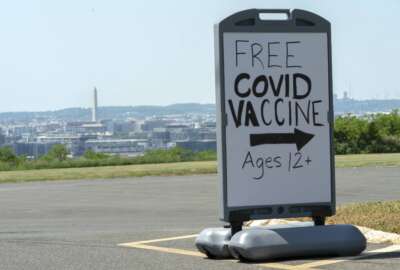This line of federal improper spending is among the most galling
Federal improper payments roll on and on, year after year. Among the most frustrating are fraudulent unemployment benefits, federal dollars that get spent by the...
Federal improper payments roll on and on, year after year. Among the most frustrating are fraudulent unemployment benefits, federal dollars that get spent by the states. Last fall, the Government Accountability Office (GAO) estimated that as much as 15% of pandemic-era unemployment spending went to fraudsters, or as much as $135 billion. For a review of GAO recommendations, Federal Drive Host Tom Temin spoke with Seto Bagdoyan, GAO’s Director of Forensic Audits.
Interview Transcript:
Tom Temin And just a quick question. The official tally is around $55 billion in pandemic relief spending that was fraudulent for unemployment benefits. But the imputed and derived number that GAO came up with has an upper limit of 135 billion, almost three times as much. Tell us about the differential there for starters.
Seto Bagdoyan Right. Great question. So the 55 billion or so, is a point in time number that is actually pretty dated by now. It was last reported around a may time frame when we were finalizing our analysis. So that is what the states report to the Department of Labor at the federal level. And these are actually cases that they’ve investigated, reviewed and made a determination that the benefit was paid out either through administrative error or fraud. Now, our estimate, the up to 135 billion that you mentioned is an estimate based on statistical and econometric modeling, which is well over my head, but it is very sophisticated pioneering work, a first of its kind estimate, and we think it’s a good one. I would also note that it’s likely understated, because we didn’t have the full picture of fraudulent cases to sample from. It’s a bit complicated, but it is a point in time estimate that gives us a good idea of how bad the problem has been.
Tom Temin And what do we understand about the mechanisms of the fraud that is in unemployment benefits individuals apply individually? But what we have seen, say, in another area that’s rife with fraud and that is Medicare, Medicaid benefits, often there’s an organization behind it submitting multiple claims from the same medical office that they’ve xeroxed off and so forth, purported medical office, this kind of thing. It’s organized. Do we know about unemployment insurance?
Seto Bagdoyan During the pandemic, the new risks that arose were from organized criminal enterprises, both domestic and foreign. They targeted the weak systems at the state level. What controls there were in place were relaxed, actually, and both the federal government and the state agencies that process unemployment relied on self-reporting and self attestation, which is the perennial bugaboo for auditors. That is just on absolutely red light in terms of increasing risk for fraud.
Tom Temin And what about the geographical variations, for example? Was one state particularly egregious and one state virtuous?
Seto Bagdoyan Well, there weren’t any virtuous ones, I must say, which is pretty sad commentary on the whole program integrity structure out there. There were states such as Arizona that were really pummeled, both from domestic and foreign actors all over. Michigan, California. You may have heard about the 18 to $20 billion number of fraudulent payments. I think it was pretty much across the board that the fraudsters probed for weak spots. And unfortunately, they found many of them and they exploited those weak spots.
Tom Temin And gosh, if you look at the upper line number there, that’s enough to fund the Homeland Security Department and the Labor Department and the Education Department all combined roughly.
Seto Bagdoyan Yeah, it is a big, big number. And as I mentioned earlier, it’s likely understated. And we will also, as we know it in our report, never fully know the full extent of fraud.
Tom Temin We’re speaking with Seto Bagdoyan. He’s director of forensic audits and investigations at the GAO. And the other part of the report states that there were, in fact, substantial multimillion dollar grants from the Labor Department. Two states, for the purposes of implementing anti-fraud. Were those completely wasted? Or could it have been worse, I suppose?
Seto Bagdoyan Well, that’s a good question. We tallied about $1.4 billion in federal assistance to the states. The states had to apply for these grants and essentially describe what they intended to do with the money. Much of that is still playing out. In fact, at the time of our reporting, the states were still planning long-term efforts to get their act together, basically. One thing I would note as part of the assistance the federal government made available these so-called tiger teams of experts that would actually go on site, essentially to states and work with them to figure out what went wrong and make a number of recommendations. We tallied over 300 total recommendations, and at the time of our report, we didn’t have any indication that any of those recommendations had actually been implemented. That’s to be expected. To be fair, these things are long-term propositions, but the recommendations have to be implemented in the spirit and intent in which they were made.
Tom Temin And you mentioned that some of the states had loosened the requirements. Did they do that on their own behest, or was that on advice of the Labor Department?
Seto Bagdoyan They mostly did it on their own. These are partnership programs. Unemployment insurance is a partnership. Federal, state, the feds, Labor Department are to provide some level of oversight and ensure accountability. But the State Workforce Agencies or SWA’s, those are the dedicated entities at each state level who run the unemployment insurance program, and they’re the ones who relax, controls or remove them altogether, relied on self-reporting and attestation, mainly because they were just absolutely slammed with applications for benefits. And in order to get the money out under such pressure, they pulled the plug on the controls and the results are massive fraud.
Tom Temin Yeah, that’s the thing that makes the blood of an accountant and an auditor curdle when you hear relaxed controls on purpose.
Seto Bagdoyan Yeah, that’s a big No-No.
Tom Temin And the sad part is that there was actually a need for unemployment insurance as a result of the pandemic.
Seto Bagdoyan Yeah, absolutely. It’s a noble thing to do, is provide people with something to live off of while things change back to normal. But you do expose yourself to a lot of fraud risk. And that’s what happened here.
Tom Temin And what has the Labor Department done since then? Now that we’ve had a period of relative peace, I mean, have they at least demanded that states reinstate their controls that would be in place in the normal good fiscal operation of any public entity?
Seto Bagdoyan So great question. We don’t have any active audits currently. What we do is we track the status of recommendations we made to the Labor Department. They are the action agency, if you will. We did not make any recommendations to the states. So they have taken some action. They’ve identified people who are at least nominally in charge of managing fraud risks and developing a strategy of sorts to counter fraud risk and some other actions. But they have a long way to go. We had a little over two dozen open recommendations at one point. I think we may have closed about 25% or so of those, but the bulk of them remain open.
Tom Temin And so it’s up to what Congress or somebody kind of put some pressure somewhere to make sure that this gets tightened up, because it sounds like it’s still a potential, even back to normal unemployment level payouts.
Seto Bagdoyan Yeah. Congressional oversight is important, and our congressional clients have been active in this space. But we also have a regular monitoring process, agencies are to report back to us on progress, especially when they have something concrete for us to look at. We will review that and see whether it is responsive to the recommendation. And then we’ll work with the agency to take steps to close the recommendation as implemented based on the evidence they provide. We don’t take just their word for it, of course. And then subsequently several years, perhaps from now when we go back and take another look at unemployment insurance, we’ll see whether those recommendations were actually implemented and what, if any, effect they had.
Tom Temin And just a final question. The pandemic, I guess, is officially over. Has been for some time. The unemployment program is a long standing program. At some point, does one kind of fade away and we’re out of whatever’s left over of pandemic issues and just back to regular unemployment as it existed before the pandemic.
Seto Bagdoyan Right. All the pandemic era programs have expired. So we are back to regular order, if you will. But the pandemic experience actually changed the risk landscape dramatically. The introduction of these organized crime entities, especially from overseas, that is a very concerning development. But the bottom line here is, if I may leave you with this, is basically don’t incur losses up front to fraud, because you are going to get very little looking at the back end. In pandemic era programs were looking at 6% recovery rate of fraudulent payments as reported by the states. And for the Pandemic Unemployment Assistance Program, the infamous PUA, which relied exclusively for a while on self-reporting. The rate of recovery is $0.04 on the dollar. At least that was at the time of our report.
Tom Temin So keep the money and forgo the claw back headlines.
Seto Bagdoyan Yeah, the claw back it’s not a way to do business. It has failed wherever and whenever it’s been tried.
Copyright © 2025 Federal News Network. All rights reserved. This website is not intended for users located within the European Economic Area.
Tom Temin is host of the Federal Drive and has been providing insight on federal technology and management issues for more than 30 years.
Follow @tteminWFED






